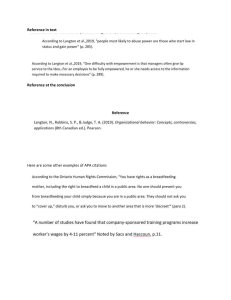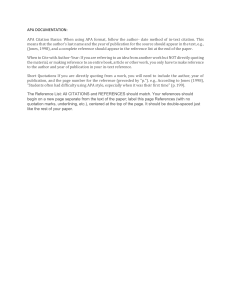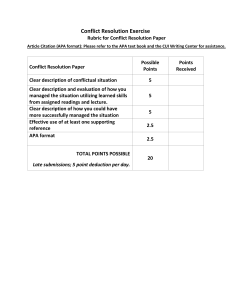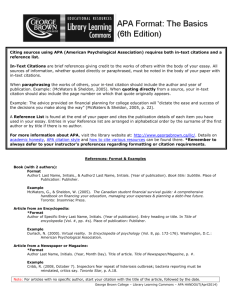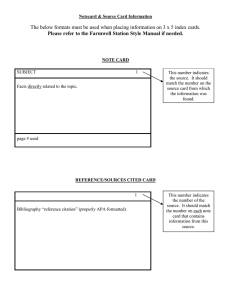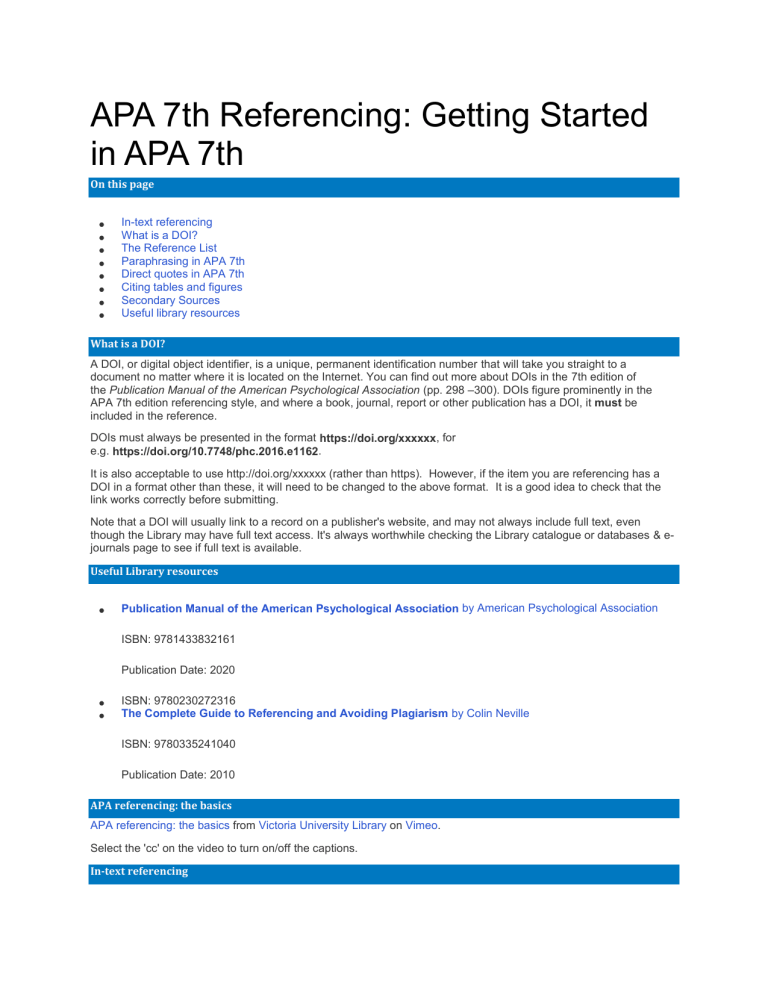
APA 7th Referencing: Getting Started in APA 7th On this page In-text referencing What is a DOI? The Reference List Paraphrasing in APA 7th Direct quotes in APA 7th Citing tables and figures Secondary Sources Useful library resources What is a DOI? A DOI, or digital object identifier, is a unique, permanent identification number that will take you straight to a document no matter where it is located on the Internet. You can find out more about DOIs in the 7th edition of the Publication Manual of the American Psychological Association (pp. 298 –300). DOIs figure prominently in the APA 7th edition referencing style, and where a book, journal, report or other publication has a DOI, it must be included in the reference. DOIs must always be presented in the format https://doi.org/xxxxxx, for e.g. https://doi.org/10.7748/phc.2016.e1162. It is also acceptable to use http://doi.org/xxxxxx (rather than https). However, if the item you are referencing has a DOI in a format other than these, it will need to be changed to the above format. It is a good idea to check that the link works correctly before submitting. Note that a DOI will usually link to a record on a publisher's website, and may not always include full text, even though the Library may have full text access. It's always worthwhile checking the Library catalogue or databases & ejournals page to see if full text is available. Useful Library resources Publication Manual of the American Psychological Association by American Psychological Association ISBN: 9781433832161 Publication Date: 2020 ISBN: 9780230272316 The Complete Guide to Referencing and Avoiding Plagiarism by Colin Neville ISBN: 9780335241040 Publication Date: 2010 APA referencing: the basics APA referencing: the basics from Victoria University Library on Vimeo. Select the 'cc' on the video to turn on/off the captions. In-text referencing APA 7th is an 'author/date' system, so your in-text references for all formats (book, journal article, web document) consists of the author(s) surname and year of publication. The basics of an in-text reference in APA: Include author or authors and year of publication. Use round brackets. Example: (Smith & Bruce, 2018) If you quote directly from an author you need to include the page or paragraph number of the quote in your in-text reference. See the 'Quotes' section below for more advice on adding quotes into your work. Include author or authors, year of publication and page or paragraph number of your quote. Use round brackets. Example: (Smith & Bruce, 2018, pp. 25-26) The Reference List All in-text references should be listed in the reference list at the end of your document. The purpose of the reference list entry is to contain all the information that a reader of your work needs to follow-up on your sources. An important principle in referencing is to be consistent. When compiling your APA Reference List, you should: List references on a new page with a centred heading titled: References. Include all your references, regardless of format, e.g. books, journal articles, online sources, in one alphabetical listing from A - Z. Order entries alphabetically by surname of author(s). List works with no author under the first significant word of the title. Indent second and subsequent lines of each entry (5-7 spaces). Use double spacing. Note that all references in APA end with a full stop except when the reference ends with a URL or a DOI. Journal article A basic reference list entry for a journal article in APA must include: Author or authors. The surname is followed by first initials. Year of publication of the article (in round brackets). Article title. Journal title (in italics). Volume of journal (in italics). Issue of journal (no italics). Page range of article. DOI (presented as a hyperlink, for example https://doi.org/xxxxx). The first line of each citation is left adjusted. Every subsequent line is indented 5-7 spaces. Example: Ruxton, C. (2016). Tea: Hydration and other health benefits. Primary Health Care, 26(8), 3442. https://doi.org/10.7748/phc.2016.e1162 Book A basic reference list entry for a book from a library database in APA must include: Author or authors. The surname is followed by first initials. Year of publication of the book (in round brackets). Book title (in italics). Edition (in round brackets), if other than first edition. Publisher. DOI (where a book has a DOI this must be included, even if you are referring to a print book). The first line of each citation is left adjusted. Every subsequent line is indented 5-7 spaces. Example: Arnott, G. D. (2017). The disability support worker (2nd ed.). Cengage Learning. Paraphrasing in APA 7th Paraphrasing is when you are summarising the words or expressing the ideas of the author(s) in your own words. When paraphrasing you must acknowledge the original source in the text of your writing. Include the author's surname and year of publication in round brackets, or if including the author(s) name anywhere in the sentence, place the year of publication in round brackets next to the author's name. (Leskowitz, 2017) OR Leskowitz (2017) When paraphrasing there is more than one way to place the citation within your text. Citation at the beginning Leskowitz (2017) describes the transcendent states that athletes experience … Citation in the middle … sport viewed as a spiritual path (Leskowitz, 2017), and one that is frequently followed in the west. Citation at the end … athletes using techniques adapted from holistic and complementary medicine (Leskowitz, 2017). Different referencing methods may highlight the importance of the author, or give more weighting to the information. Author-prominent citations In his research, Leskowitz (2017) explores mindfulness, biofeedback … Information-prominent citations … applying up-to-the-minute advances in holistic and complementary medicine (Leskowitz, 2017). Including page numbers in a paraphrase citation Although APA 7th does not require page numbers when paraphrasing another's work, you may choose to include page numbers particularly when dealing with a lengthy or complex document. A number of holistic practices and dispositions can be applied when training or coaching athletes to increase the likelihood of athletes getting into 'the Zone' (Leskowitz, 2017, p. 324). Direct quotes in APA 7th For direct quotes of less than 40 words, incorporate them into the text and enclose the quote with double quotation marks, e.g. Narrative quote (where the authors are named in your sentence): Webber (2018) concludes that “addressing the issue of school dropout not only affects the education system, but may also serve as a prevention effort for the welfare, mental health, and corrections systems” (p. 82). Parenthetical quote (where the citation details are presented in parentheses following the quote): "Addressing the issue of school dropout not only affects the education system, but may also serve as a prevention effort for the welfare, mental health, and corrections systems" (Webber, 2018, p. 82). For direct quotes of 40 or more words start on a new line and indent the whole block ~1cm from the left, do not add any additional space before or after the quote. The entire quote should be double-spaced. Quotation marks are not required e.g.: Others have contradicted this view, suggesting: These overload issues can reach across the lifespan and affect individuals in many ways. As related issues continue to emerge, counselors will need to be aware of potential mental health problems stemming from technology overload and continue to research and develop the skills needed for effective interventions. In the digital age, these capabilities will be crucial in helping clients regain and maintain a healthy balance of life, work, and technology. (Scott et al., 2017, p. 605) *NOTE: Use paragraph numbers if no page numbers are available. Ellipses '…' and Quotes It is common when writing to use an ellipsis (3 fullstops in a row '…') to indicate where words have been omitted from a sentence. This is not permitted in quotes in APA: 'Regardless of quotation length, do not insert an ellipsis at the beginning and/or end of a quotation unless the original source includes an ellipsis" (APA, 2020, p. 271). This Guide makes use of ellipses in some paraphrasing examples due to limited space. To avoid confusion we have removed them from all quote examples. Citing tables and figures Figures include graphs, charts, maps, drawings and photographs. Tables are numerical values or text displayed in rows and columns. Including figures or tables in your work When including figures or tables in your work, please note: All figures and tables must be referred to in the main body of the text. Number all figures and tables in the order they first appear in the text. Refer to them in the text by their number. For example: As shown in Table 4... OR As illustrated in Figure 3... Example of an in-text Figure Each figure should be accompanied by a concise title that provides a brief but clear explanation of its contents, this is presented directly below the figure number and above the figure itself. The title is given in Title Case and italics. Figure 3 Figure or Table Title When reproducing a figure or table from another source you must also include an attribution (Creative Commons or copyright), presented in a Note directly below the figure/table. The attribution will follow any explanatory notes required for the figure. An attribution for a figure reproduced from an Open Access journal article with a Creative Commons licence must include: o 'From' when reprinting the figure or 'Adapted from' when adapting o Title of article, in Title Case and double quotation marks " " o by Author(s). The first initial(s) followed by the surname o Year of publication o Journal title, in Title Case and italics o Volume (in italics) and issue number in (round brackets) o Page number of original figure. (Where there are no page numbers use Section headings and paragraph numbers) o DOI or URL, in (round brackets) o Creative Commons licence Example: Note. (A) Expression Recognition & (B) Expression Detection (A = Anger; D = Disgust; F = Fear; H = Happy; Su. = Surprise; Sa. = Sad). (C) Full confusion matrices underlying performance at each eccentricity for the Emotion Recognition Task (rows = expression presented; columns = response chosen). From "Identifying and Detecting Facial Expressions of Emotion in Peripheral Vision," by F. W. Smith and S. Rossit, 2018, PloS ONE, 13(5), Results section, Figure 1 (https://doi.org/10.1371/journal.pone.0197160). CC BY. IMPORTANT: If a figure is not Open Access or Creative Commons, you may need to obtain written permission from the copyright holder to reproduce or adapt a figure or table. The copyright permission statement should be included at the end of the Note. See the APA Publication Manual pp. 389-391 for advice on copyright permission statements. You must also list the figure in your Reference list. Notice that the order of the citation elements and capitalisation differs slightly in the figure note compared to the reference list: Smith, F. W., & Rossit, S. (2018). Identifying and detecting facial expressions of emotion in peripheral vision. PLoS ONE, 13(5), Article e0197160. https://doi.org/10.1371/journal.pone.0197160 Discussion of a figure in another source Follow a discussion of a figure viewed in another source (but not reproduced) with an in-text citation for the published source. Include the figure number as it appears in the published source. Cite the source in full in your reference list: On analysing the recognition of different facial expressions at different degrees of eccentricity, Smith and Rossit (2018, Results section, Figure 1) found … Reference List: Smith, F. W., & Rossit, S. (2018). Identifying and detecting facial expressions of emotion in peripheral vision. PLoS ONE, 13(5), Article e0197160. https://doi.org/10.1371/journal.pone.0197160 Secondary sources APA discourages the use of secondary sources unless the original work is unavailable. If you read an article or book which references some information that you also want to reference and you have been unable to locate the original source, cite the source you have read in the Reference list; in text, name the original work and give the citation for the source where you found the information. Where the year of publication for the original work is known, include it. For example: Sue reads an article by Chris Brown in the Journal of Library Administration in which he cites or refers to statements made by Ulrich Boser in his 2017 book ‘Learn Better’. Sue wants to refer to Boser’s statement in her assignment. Sue would acknowledge Boser in her text but her reference is to the source where she saw the information. Sue might write as her in-text reference: ... (Boser, 2017, as cited in Brown, 2018) OR Boser (2017, as cited in Brown, 2018) states ... In her reference list Sue would write a reference for Brown's article because that's where she sourced the information. The entry in her References would be: Brown, C. (2018). Creating better learners through learning science: A sample of methods. Journal of Library Administration, 58(4), 375381. https://doi.org/10.1080/01930826.2018.1448652 Copyright © 2015 CRICOS Provider No.00124K (Melbourne) and CRICOS Provider No. 02475D (Sydney). RTO Code: 3113.
